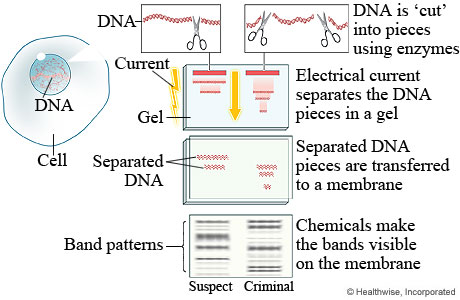DNA Fingerprinting in a Criminal InvestigationCurrent as of: October 9, 2017 Author: Healthwise Staff Medical Review: Kathleen Romito, MD - Family Medicine & Siobhan M. Dolan, MD, MPH - Reproductive Genetics |
|
DNA Fingerprinting in a Criminal Investigation
The first step in DNA fingerprinting is to break open the sample cells and collect the DNA. Next, many copies of the DNA are made using polymerase chain reaction (PCR). To get the DNA fingerprint:
For a criminal investigation, photos of the criminal and suspect DNA are compared. The results in this case show that the suspect is not the criminal. Current as of: October 9, 2017 Author: Healthwise Staff Medical Review: Kathleen Romito, MD - Family Medicine & Siobhan M. Dolan, MD, MPH - Reproductive Genetics |
Search the
Healthwise Knowledgebase This information does not replace the advice of a doctor. Healthwise, Incorporated, disclaims any warranty or liability for your use of this information. Your use of this information means that you agree to the Terms of Use. Learn how we develop our content. To learn more about Healthwise, visit Healthwise.org. © 1995-2018 Healthwise, Incorporated. Healthwise, Healthwise for every health decision, and the Healthwise logo are trademarks of Healthwise, Incorporated. |